Time and again shows and movies have taught us that humans don’t last long in a tank full of Piranhas due to their highly predatory nature. We believe no creature can survive in the same tank as these flesh-eating fish.
Contrary to this belief, Piranhas can take some selected tank mates and live in harmony with them, or at least try to. The survival here is dependent equally on the tank fish’s nature and the tank’s size and temperature.
If you are considering adding another species to your Piranha tank, never fear! FishLab is here with insights you need to choose good Piranha tank mates.
Contents
Piranha Tank Mates – What You Need To Know
Temperament:
Piranhas are notorious for their aggressive and territorial nature. When choosing tank mates, it’s important to consider species that can handle their aggressive behavior. Avoid small, slow-moving, or timid fish that may be seen as easy targets or trigger aggressive responses from the piranhas.
Size:
Select tank mates similar in size to the piranhas or larger. Smaller fish may be perceived as food and become targets of aggression or predation. Similar-sized or larger fish are more likely to hold their ground and establish their territories within the tank.
Competition
Piranhas are primarily carnivorous and may view other fish as competition for food. Therefore, it’s advisable to choose tank mates with different dietary preferences, reducing the chances of intense competition for food and minimizing aggression. Additionally, avoid species with long, flowing fins that could be mistaken for prey.
Parameters & Tank Setup
Piranhas prefer warm water conditions. Maintain a temperature between 75°F and 82°F (24°C to 28°C) and a pH level around neutral (6.5 to 7.5). It’s crucial to provide a spacious tank with plenty of hiding spots, plants, and decorations to create territories and alleviate aggression. Dense vegetation and hiding places can also allow tank mates to escape the piranhas if necessary.
Piranha Tank Mates
You will also like these other popular posts in this category:
1. Oscar Fish
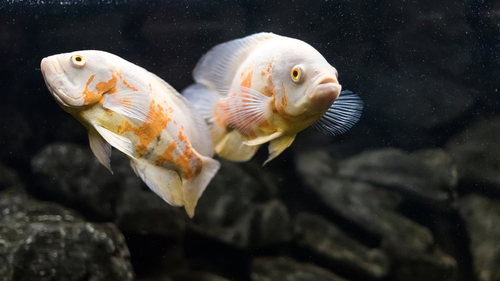
- Scientific Name: Astronotus ocellatus
- Adult Size: 10 – 16 inches
- Compatible with: Jack Dempsey, Common Pleco, Firemouth, and Clown Loaches.
- Care Level: Moderate, as they are susceptible to diseases such as hole in the head disease.
- Origin: South America
Oscar fish have made their way to the top of this list due to some unique characteristics they possess. The main reason for their ability to survive with the piranhas is their size and equally aggressive nature, if not more. Oscars are enormous and are particularly strong cichlids.
Because of these characteristics, they make good companions when in the same tank as Piranhas. Due to their size and resilience, they are placed in similar tanks and require almost the same conditions as piranhas. The point to note here is that for the survival of the Oscars, they must be larger than the piranhas.
Pros of keeping with Piranha
Since Oscars can make their place easily in a tank due to their resilient and fearless nature, they can live in harmony with other fish known to be aggressive without issues.
Cons of keeping with Piranha
If the size of the Oscars is smaller than the Piranhas, they can become easy targets to the meat-loving fish instead of surviving with them.
2. Jack Dempsey
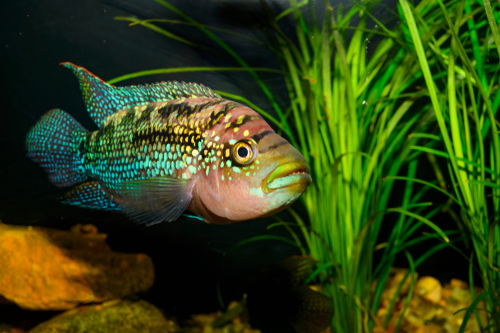
- Scientific Name: Rocio octofasciata
- Adult Size: Up to 8-10 inches
- Compatible with: Hoplo Catfish, Common Pleco, Firemouth Cichlid, Iridescent Shark, Blue Acara
- Care Level: Low – They are adaptable and hardy
- Origin: Southern Mexico
Named after the American boxer, the Jack Dempsey cichlid is a tough fish that should have no problem coexisting with Piranhas! Jack Dempseys have made a mark in the aquatic world because of their unique combination of size, durability, distinct colors, and shiny, shimmery scales. They range in colors and can be silver, pink, green, blue, and even purple!
The younger the fish is, the more prominent their colored fins are. This coloration not only gives them a distinctive look but also lets their owners know the health levels of the fish – if the colors dull out, the fish is most probably struggling with its health.
Like the Oscars, Jack Dempseys are another fish type that can make good tank mates with Piranhas. The Jack Dempsey is a large, powerful cichlid with a reputation for aggression, much like the Oscar fish. It may be easier for them to form their territories and cohabit in the same tank because they are comparable to piranhas in size and attitude.
Pros of keeping with Piranha
Jack Dempsey displays a unique mating pattern and is known to stick to one mate for life. For individuals interested in expanding their tank with these fish, raising the population with one pair is highly likely.
Cons of keeping with Piranha
These fish are not the most suited for living in a community tank because the older they get, the more powerful and aggressive they can be. If you keep these fish until they reach their maximum potential, these mood swings must be considered!
3. Silver Dollars

- Scientific Name: Metynnis species
- Adult Size: Up to 6 inches
- Compatible with: Angelfish, Blue Ram Cichlid, Bala Shark
- Care Level: Easy
- Origin: South America
With their sparkling silver scales and round shape, it’s easy to see why they’re called Silver Dollars. Silver Dollar fish are a fantastic addition to most community tanks since they are calm to the point of becoming bashful. Keeping a group of multiple Silver Dollars will help combat their shyness.
They are distant cousins of the dreaded piranhas, believe it or not! The shiny scales, red color, and face form all bear a striking likeness. The distinction is that although piranhas are primarily or wholly carnivorous, Silver Dollar fish are entirely vegetarian.
Silver Dollars need space to grow to their maximum size. However, apart from the tank size requirement, these fish are exceptionally easygoing. They live for many years and are a great source of entertainment in community tanks!
Pros of keeping with Piranha
Silver Dollars have a peaceful nature and don’t display aggression. They can thrive in community tanks and are enjoyable to watch.
Cons of keeping with Piranha
These fish require special tanks with a solid lid to cover the top because silver dollars tend to jump, often out of the tank when stressed, and can die outside of the aquarium.
4. Delhezi Bichir
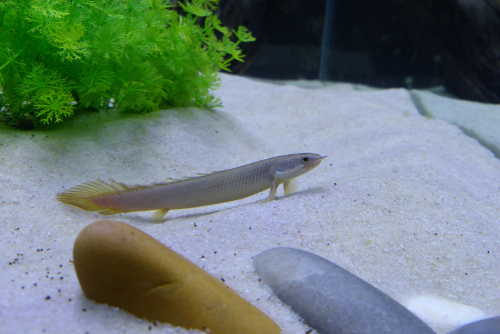
- Scientific Name: Polypterus delhezi
- Adult Size: Up to 17 inches
- Compatible with: Polypterus, Datnoides, Synodontis, African Butterfly Fish, Knife Fish
- Care Level: Easy
- Origin: Central Africa
The middle stretch of the Congo River in Central Africa is home to the Delhezi Bichir, sometimes known as the barred, banded, or armored bichir. It is a nocturnal carnivorous catfish with ancient roots.
This resilient living fossil fish has around a dozen short black stripes and is dotted with yellow and green spots. It will give your aquarium a fantastic prehistoric vibe and is generally simple to care for.
A fascinating fact to consider when harboring a Delhezi Bichir is that they are fantastic escape artists. There must be room above the surface for your bichir to breathe because these fish must breathe atmospheric oxygen to survive. However, your Delhezi Bichir will almost surely escape the tank and land on the floor with a sufficient aquarium cover.
Pros of keeping with Piranha
This fish has a fascinating prehistoric appearance, resembling the eye-capturing fish of ancient times.
Cons of keeping with Piranha
These fish tend to grow to great lengths, and keeping them in tight spaces is both unjust and unhealthy for the fish.
5. Common Pleco
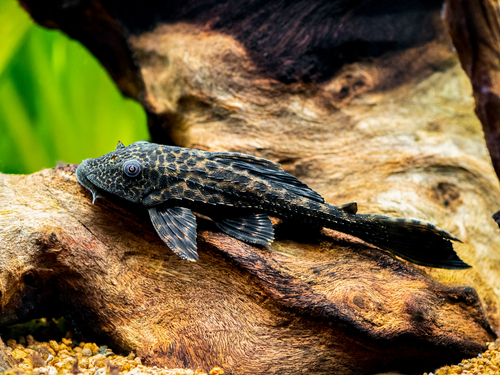
- Scientific Name: Hypostomus plecostomus
- Adult Size: 12 – 24 inches
- Compatible with: Swordtails, Mollies, Tiger Barbs, Neon Tetras, Zebra Danios
- Care Level: Moderate to Difficult
- Origin: South America
Common plecos can be easily found in most fish stores. Plecos are often purchased for their ability to eat unwanted algae in the tank. This combined with their easy-to-care-for nature and entertaining personalities make them a popular choice of aquarium enthusiasts worldwide. Because of the shape of their mouths and the way they slide across objects in the aquarium like a vacuum in search of algae to eat, these fish are often called “sucker fish.” Common plecos also have an extremely tough exterior. This “armor” and their size make them almost impossible for most fish to prey on.
Pros of keeping with Piranha
Common plecos are naturally drawn to algae as a food source and they have a voracious appetite. These fish can be a great resource for keeping algae growth to a minimum.
Cons of keeping with Piranha
Common plecos require large tanks to cater to their massive size. If their large size is not considered, the plecos and their tank mates will experience discomfort.
6. Tinfoil Barbs

- Scientific Name: Barbonymus schwanenfeldii
- Adult Size: 14 – 16 inches
- Compatible with: Silver Dollar, Plecos, Oscar Cichlid, Angelfish, Bala Sharks
- Care Level: Easy
- Origin: Southeast Asian countries, including Thailand, Malayan Peninsula, Sumatra, and Borneo.
Tinfoil barbs are large freshwater fish from the Cyprinidae family called Tinfoil Barbs. Other names for this fish include Silver Barb Fish, Tinfoil Fish, and Red Tail Tinfoil Fish. The enormous silver bodies of Tinfoil Barbs have a shiny shine reminiscent of tin foil, and they occasionally have a golden hue.
Their dorsal fin has a black patch at the tip, and each tail fin lobe has a black line close to the edge. Their fins range in color from orange to blood red. Tinfoil Barbs can be easily kept with the right tank size and careful attention to the water’s quality.
The tank must have effective filtration to keep the water circulating and well-oxygenated because the Tinfoil Barb cannot handle low oxygen levels well. Tinfoil Barbs also need clean water, and depending on how crowded the tank is, they need frequent water changes of between 20 and 25 percent every 1-2 weeks.
Pros of keeping with Piranha
Tinfoil Barbs enjoy swimming vigorously and want to be kept in groups of at least six. They engage in schooling behavior, which can be visually pleasing and add to the aquarium’s dynamism.
Cons of keeping with Piranha
Tinfoil Barbs love to eat plants. They might destroy or eat aquarium plants that are alive. It’s best to choose hardy plant species or give enough hiding areas if you have a planted tank to reduce plant damage caused by these fish.
7. Severum Cichlid
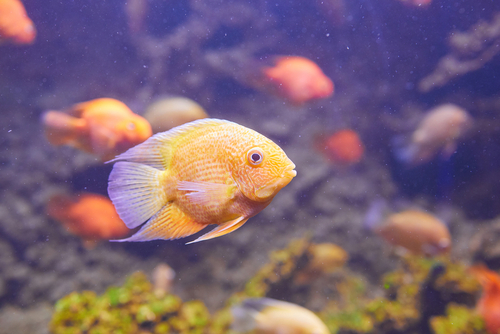
- Scientific Name: Heros severus
- Adult Size: 8-10 inches
- Compatible with: Angelfish, Oscar, Blood Parrot Cichlid, Hoplo Catfish Black Skirt Tetra
- Care Level:
- Origin: South America
Freshwater fish called Severum Cichlids are also called Banded Cichlids and Poor Man’s Discus. Severum Cichlids are colorful, calm, and lively fish. Their beauty intensifies as they expand.
They are simple to breed and given the proper care, can live for many years. They are one of the most vibrant cichlid species that may be kept in a tank at home. They are popular aquarium fish due to their attractive personalities and colorful bodies.
Severum cichlids are robust fish that require little maintenance. They can survive in challenging environments that would be unfavorable or even detrimental to other fish in the wild.
Despite their hardiness, appropriate tank setup and routine maintenance are still necessary. The fish will remain healthy and less prone to illness with proper care.
Pros of keeping with Piranha
Due to their calm yet hardy nature, these fish make excellent tank mates for several species and often thrive in joined environments.
Cons of keeping with Piranha
Is susceptible to health issues such as Ich.
8. Green Terror
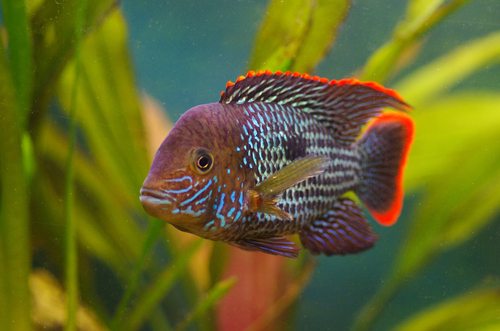
- Scientific Name: Andinoacara rivulatus
- Adult Size: Up to 12 inches
- Compatible with: Jack Dempsey, Firemouths, Managuense Cichlids, Flowerhorns, Silver Dollars
- Care Level: Easy to Moderate
- Origin: South America
The most significant order of fish, Perciformes, includes the Green Terror Cichlid, a gigantic fish. They feature stunning metallic blue and green colors and sharp dorsal fins. Cichlids identified as Green Terror are also called Gold Saum or White Saum.
The Green Terror Cichlid, ironically, is not a completely green fish. The males’ brilliant blue and green metallic coloring is accentuated by an orange line that delineates the tail fin and the dorsal fin tip.
The caudal and dorsal fins of females are darker, smaller, and lack the striped-orange pattern entirely. In addition, they come in pink, crimson, and electric blue. The face is covered with blue and green striped and spot patterns.
No matter how easygoing they may be, Green Terrors can thrive well with fish that are the same size or bigger than them. Smaller fish will become easy prey to these predators.
Pros of keeping with Piranha
These fish are active and enjoy exploring the tank. They will reach every nook and corner, top and bottom, of the tank they inhabit.
Cons of keeping with Piranha
If deprived of their ideal growth requirements, the Green Terror fish tend to get agitated and display aggressive behaviors. A small tank will also affect their exploration habits and prevent them from growing to their maximum length.
9. Red Devil Cichlid
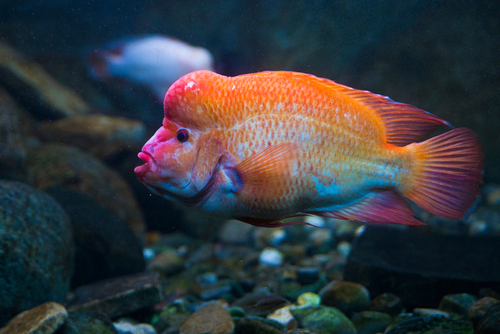
- Scientific Name: Amphilophus labiatus
- Adult Size: Up to 16 inches
- Compatible with: Red Devil Females and Firemouth Cichlid
- Care Level: Easy
- Origin: Central America
Red Devil Cichlids are unique fish that are true to their name. They are an exceptionally aggressive species and need a huge tank to coexist peacefully with other fish.
Others in the tank should avoid them due to their hazardous bite and prominent fangs. They are so vicious that they have been known to ram tanks’ glass, smash into other equipment, shatter heaters, and even bite their owners.
However, this fish’s tendency to be very “owner conscious” is one of its essential selling qualities. Red devil cichlids may bond with their owners extremely fast and even “play” with them as other pets do.
They occasionally have been observed to follow their owner about, put on shows, beg for food, and act generally playful. They will respond to the owner even when fed or having the tank cleaned.
Pros of keeping with Piranha
Red Devil Cichlids are known to display interesting breeding behaviors. They may form pairs, excavate nesting sites, and guard their fry fiercely. Breeding Red Devil Cichlids can be a rewarding and educational experience for hobbyists.
Cons of keeping with Piranha
Obesity brought on by overeating is a common issue with Red devil cichlid. It is crucial to keep an eye on what the fish eat because this could worsen the function of their organs.
10. Convict Cichlid
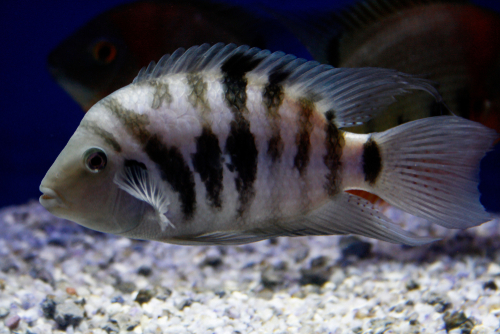
- Scientific Name: Amatitlania nigrofasciata
- Adult Size: 4 – 6 inches
- Compatible with: Blood Parrot, Oscars, Angelfish, Pleco
- Care Level: Easy
- Origin: Central America
Convict cichlids are typical aquarium fish that may be kept with relative ease in the hands of the correct owner. Like prison uniforms, their black and white stripes give them the moniker Convict Cichlid. Convicts are on the smaller side of the scale when compared to other cichlids.
Despite their smaller size, Convict Cichlids can still be a very aggressive fish. Convicts reproduce quickly, sometimes even without the keeper even trying, so this might be a good option if you are searching for a simple fish to breed.
As omnivores, convicts make the keeper’s life easier because they typically eat almost anything. They have been observed to consume a range of foods in the wild, such as insects, plant residue, and mosquito larvae, but in an aquarium, they will consume nearly anything put in front of them. Consequently, traditional cichlid food will do.
Pros of keeping with Piranha
Despite their territorial nature, these fish can coexist with certain community fish. They can be housed with other robust and similarly-sized species with sufficient space and enough hiding spots.
Cons of keeping with Piranha
Convict Cichlids are prone to several diseases, including Hole in the Head, Tuberculosis, Gill flukes, Ich Disease, and Cotton Wool Disease, which means their lifespans can be unpredictable and often require effort to keep them disease free.
11. Firemouth Cichlid

- Scientific Name: Thorichthys Meeki
- Adult Size: Up to 6 inches
- Compatible with: Rummy Nose Tetra, Clown Pleco, Bristlenose, Rainbowfish, Swordtails
- Care Level: Easy
- Origin: Central America
The Firemouth Cichlid, a variety of cichlid native to Central America, is a very well-liked fish among aquarium hobbyists because of their incredible beauty and color they add to the tank. Their names convey a unique sense of territoriality. When displaying their bright red throats and establishing their dominance, male Firemouth cichlids frequently flare and puff up their gills.
Warm, still waters with little current are a typical habitat for Firemouth cichlids, one of the main factors contributing to the popularity of Firemouth cichlids. They are easy to care for and don’t require considerable space to thrive.
The Firemouth cichlids are highly captivating and can be either red or grey. The black spot on the lower portion of the operculum is another distinctive feature of the Firemouth cichlid.
Additionally, they could have dark lateral bars. The Firemouth cichlid is ideal for your aquarium if you want an attractive, low-maintenance fish.
Pros of keeping with Piranha
These fish stay peaceful throughout their lives and pose little to no threat to their fellow tank mates, provided they have food and enough space to move around.
Cons of keeping with Piranha
Firemouths may exhibit fin-nibbling behavior, particularly with fish with long, flowing fins, such as angelfish, which can result in torn or damaged fins and cause stress to the targeted fish.
12. Giant Gourami
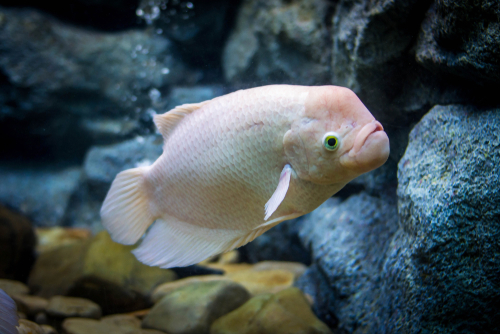
- Scientific Name: Osphronemus goramy
- Adult Size: 16 – 18 inches
- Compatible with: Oscar, Blood Parrot, Pleco, Redtail Catfish
- Care Level: Easy
- Origin: South Asia
The Giant Gourami, sometimes known as the True or Common Gourami, is the largest gourami species. This Gourami is a true behemoth in terms of tank size, living up to its name. Because of their enormous size, many amateur aquarists cannot handle them as aquarium pets.
Generally speaking, aquarists advise a tank size of at least 200 gallons. A Giant Gourami may be recognized by its flathead and pointed snout. Their bodies typically have silver or grey stripes, yet they tend to vanish as they age.
They only need a little maintenance or care to flourish. The Giant Gourami tank must imitate their native settings in South Asia and contain enough greenery for them to feel at home.
Pros of keeping with Piranha
These fish are loners and can survive independently with no schools. Therefore, going out of your way to find tank mates for them is unnecessary.
Cons of keeping with Piranha
Giant Gouramis are messy eaters, and they can create a significant amount of waste, which can strain the filtration system and require excessive maintenance. Adequate filtration and regular water changes are necessary to maintain the aquarium.
13. Red-tailed Catfish
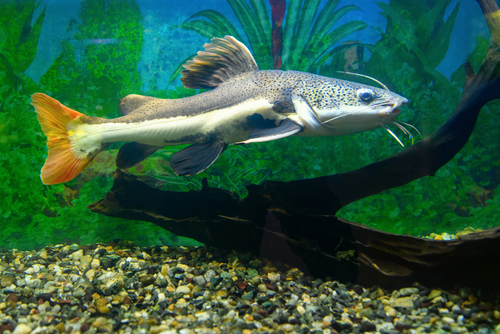
- Scientific Name: Phractocephalus hemioliopterus
- Adult Size: 4-5 feet
- Compatible with: Other Red Tail Catfish, Gars, and Freshwater Stingrays
- Care Level: Hard
- Origin: South America
The Red-tailed Catfish is one of the largest predatory fish, known for their striking appearance and impressive size. When Redtail Catfish are young, they grow pretty quickly. A typical growth rate for this fish species is 1 inch per week.
They outgrow most home aquariums in their first year due to their rapid growth, and for the majority of redtail catfish, it’s not surprising to see them grow to over two feet long in their first year!
For this reason, it is crucial to have a tank big enough to hold them when they’re entirely grown. Redtail Catfish require big tanks, which most home aquarium hobbyists must possess. Because of this, Redtail Catfish are typically kept in public aquariums or zoos.
Pros of keeping with Piranha
They are fascinating to view and have a long lifespan.
Cons of keeping with Piranha
These fish may not be available in all areas or readily accessible for purchase. They are considered more specialized and may require extra effort to acquire compared to other fish species.
14. Striped Raphael Catfish
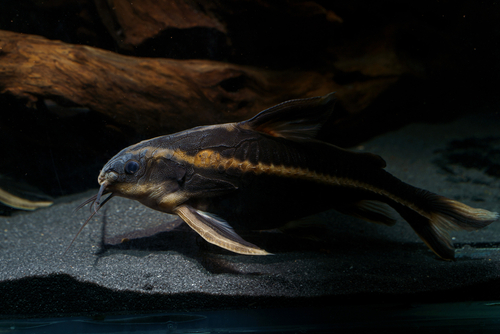
- Scientific Name: Platydoras Armatulus
- Adult Size: 8 – 9.5 inches
- Compatible with: Other fish of the same specie
- Care Level: High
- Origin: South America
The striped Raphael Catfish is a unique species of fish known for its deep dark skin with distinct stripes. The body shape of the striped Raphael catfish is more rounded, and their heads and tails are pointed. They have lovely flat bellies and silver and black striped bodies. Three sets of barbels are present on the mouths of striped Catfish.
The top lip has one pair of barbels, and the lower lip has the other two sets. Barbels serve as taste buds and aid animals in locating food in muddy waters.
Along with having sharp fins, striped Raphael catfish also have spines on their backs. They use their spines to protect themselves from predators.
When out of the water, striped Raphael catfish will grunt or squeak. Because of this, some fish keepers even call these fish “talking cats.”
Pros of keeping with Piranha
Since these fish work best with their species, purchasing similar fish and allowing them to live together means less diverse purchases need to be made, and a joyous aquatic setup can be achieved with only a few requirements.
Cons of keeping with Piranha
Apart from adjusting the tank size according to the enormous size of the fish, temperatures also have to be moderated for these fish to thrive. Additional heaters are required to maintain the water temperatures wherein the fish can survive.
15. African Arowana
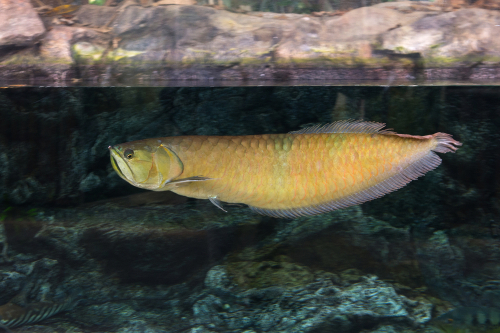
- Scientific Name: Heterotis niloticus
- Adult Size: 3.3 feet
- Compatible with: Cichlids, Xenomystus, Synodontis, Astronotus, Oscars, and Channel Catfish
- Care Level: Hard
- Origin: Watersheds throughout Africa
African Arowana is freshwater fish in African watersheds like the Nile River, Lake Chad, and Lake Turkana. It has been harvested for the aquarium trade and fished as a food source.
The African Arowana has a lengthy body and distinctive shimmering scales. Its dorsal and anal fins are positioned very far back on its body. The tail of the fish is rounded.
The African Arowana’s nose is rounded for a shovel to dig up small animals to eat. They come in bronze, brown, or grey colors. Adult fish have uniform coloration all over their bodies.
Dark stripes that run the length of a young fish’s anatomy are possible. These fish are fascinating since they can breathe air and use this ability to survive in water with low oxygen levels.
Pros of keeping with Piranha
These fish are peaceful and can be kept with a variety of non-aggressive fish species. They are unlikely to display aggression towards tank mates and can coexist in a community setup.
Cons of keeping with Piranha
This is another fish that eats and breathes on the surface of the water. There must be space at the top of the tank and an aquarium lid because this fish is commonly know for jumping out of the tank.
Summary
When considering tank mates for piranhas, several factors need to be considered. The temperament of the piranhas is essential, as they are known to be aggressive and territorial. Choosing tank mates that can handle their aggressive behavior is crucial to ensure the safety and well-being of all the fish in the aquarium.
Choosing suitable tank mates for piranhas requires considering their temperament, size compatibility, resource competition, and tank setup. It is essential to select fish that can handle their aggression, is similar or larger, and can peacefully coexist while meeting their needs.
Proper planning and research are crucial to create a harmonious and thriving community aquarium with piranhas.
FAQs
Some frequently asked questions regarding Piranha Tank Mates are mentioned below.
Are there any non-fish tank mates that can be kept with piranhas?
It is generally not recommended to keep non-fish tank mates with piranhas. Piranhas are primarily carnivorous and may see smaller animals, such as snails, shrimp, or frogs, as potential food. Additionally, the aggressive nature of piranhas may lead to harm or stress for non-fish tank mates. It is best to focus on selecting suitable fish species as tank mates for piranhas.
How should I introduce tank mates to a piranha tank?
When introducing tank mates to a piranha tank, it is recommended to rearrange the tank’s decor to disrupt existing territories and reduce aggression. Simultaneously adding new fish can help distribute attacks among all the newcomers.
Monitoring the tank closely for signs of aggression and providing ample hiding spots can also help reduce stress and potential harm. It is crucial to have a backup plan to remove any tank mates that experience excessive aggression or become injured.

JJ has had a passion for learning about aquatic life since age 5. As an adult, he made his passion a career as a certified aquaculture dealer and aquarium content creator.


